Questionnaire Design for Business Research Methods Report - BMO6630
VerifiedAdded on 2023/06/04
|8
|1438
|404
Report
AI Summary
This report details the design and structure of a questionnaire developed for a business research methods assignment, focusing on the study of conspicuous consumption among Australian domestic and international travelers. The questionnaire, comprising 19 questions (13 main and 6 sub-questions), incorporates both open-ended and closed-ended questions to gather quantitative and qualitative data. The report meticulously outlines the different question formats, including multiple-choice, and the scaling techniques employed, such as Likert, semantic differential, ordinal, and nominal scales, to ensure the collection of comprehensive and relevant data. The report also provides a step-by-step overview of the questionnaire design process, starting with a review of academic literature and market information, followed by the development of questions, and concluding with testing and refinement. The goal is to understand the factors influencing conspicuous consumption, including socio-demographics, cultural values, shopping motivations, and experiences. References to relevant academic sources are included to support the methodological choices.
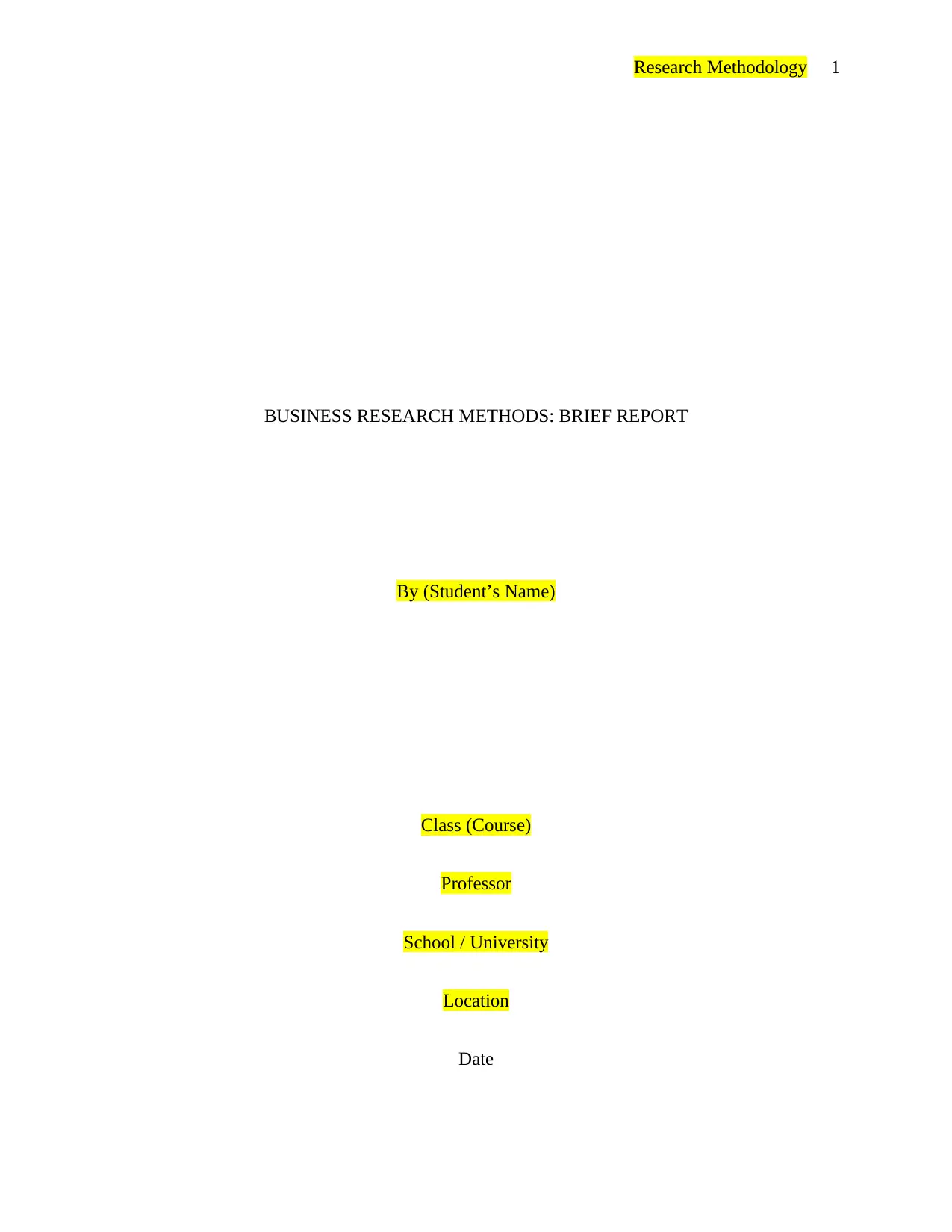
Research Methodology 1
BUSINESS RESEARCH METHODS: BRIEF REPORT
By (Student’s Name)
Class (Course)
Professor
School / University
Location
Date
BUSINESS RESEARCH METHODS: BRIEF REPORT
By (Student’s Name)
Class (Course)
Professor
School / University
Location
Date
Paraphrase This Document
Need a fresh take? Get an instant paraphrase of this document with our AI Paraphraser
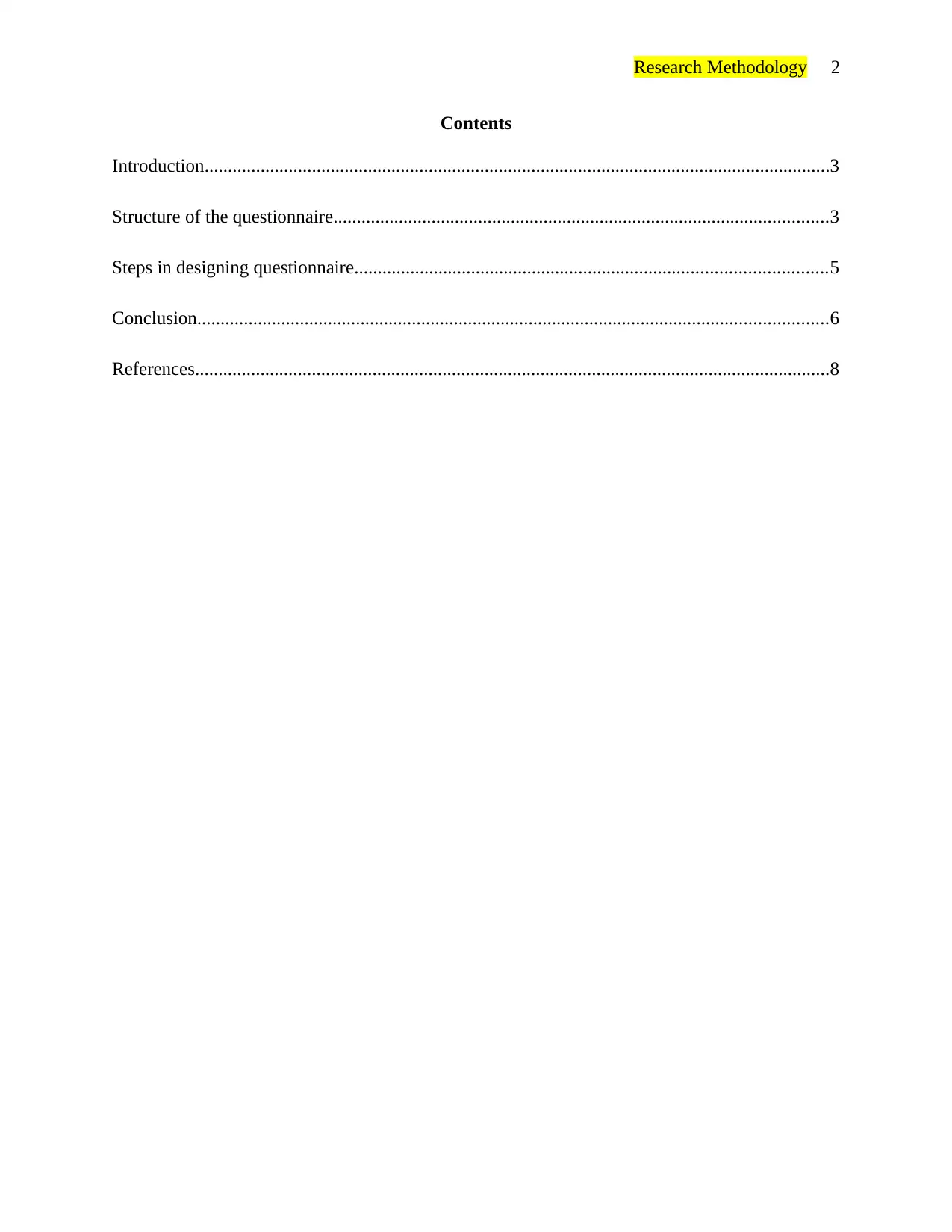
Research Methodology 2
Contents
Introduction......................................................................................................................................3
Structure of the questionnaire..........................................................................................................3
Steps in designing questionnaire.....................................................................................................5
Conclusion.......................................................................................................................................6
References........................................................................................................................................8
Contents
Introduction......................................................................................................................................3
Structure of the questionnaire..........................................................................................................3
Steps in designing questionnaire.....................................................................................................5
Conclusion.......................................................................................................................................6
References........................................................................................................................................8
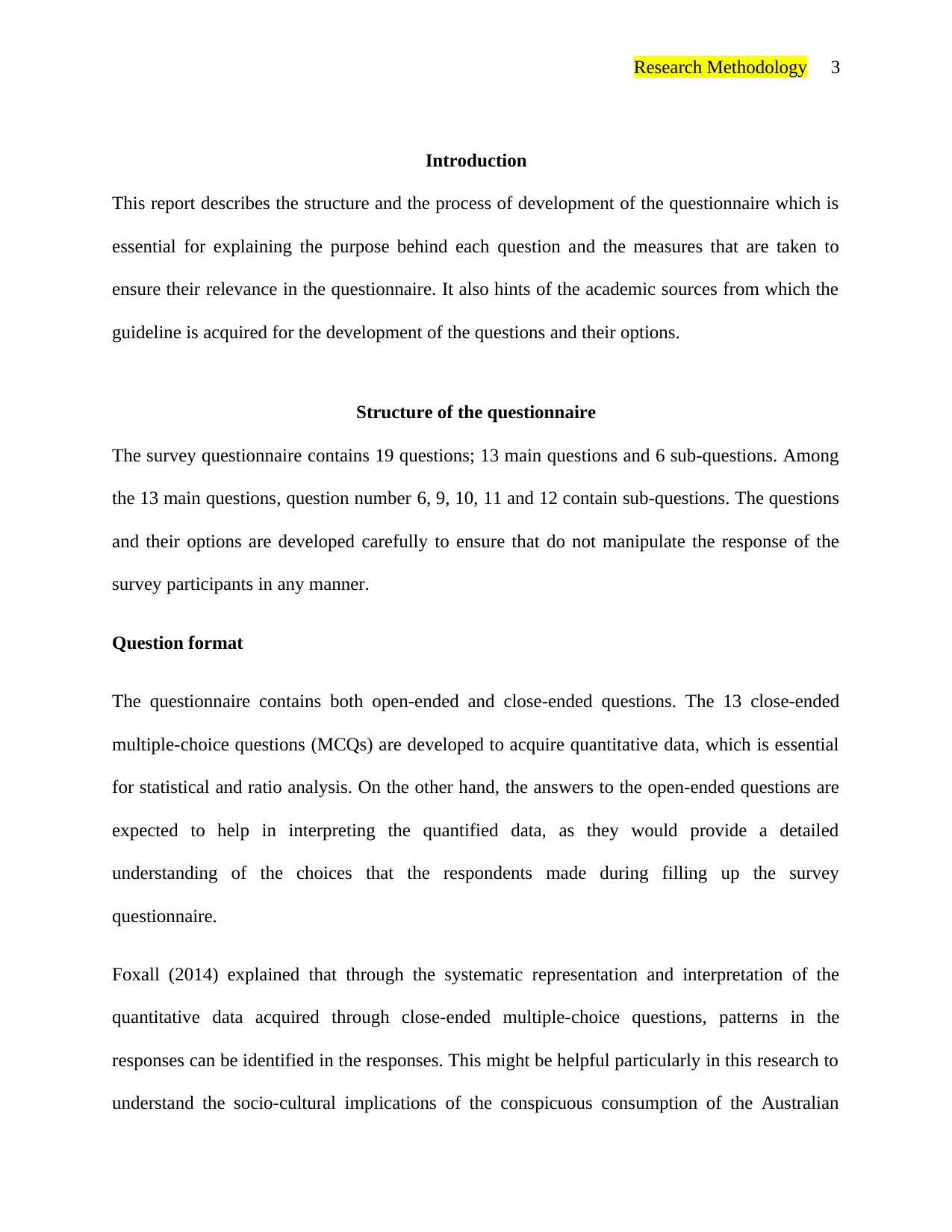
Research Methodology 3
Introduction
This report describes the structure and the process of development of the questionnaire which is
essential for explaining the purpose behind each question and the measures that are taken to
ensure their relevance in the questionnaire. It also hints of the academic sources from which the
guideline is acquired for the development of the questions and their options.
Structure of the questionnaire
The survey questionnaire contains 19 questions; 13 main questions and 6 sub-questions. Among
the 13 main questions, question number 6, 9, 10, 11 and 12 contain sub-questions. The questions
and their options are developed carefully to ensure that do not manipulate the response of the
survey participants in any manner.
Question format
The questionnaire contains both open-ended and close-ended questions. The 13 close-ended
multiple-choice questions (MCQs) are developed to acquire quantitative data, which is essential
for statistical and ratio analysis. On the other hand, the answers to the open-ended questions are
expected to help in interpreting the quantified data, as they would provide a detailed
understanding of the choices that the respondents made during filling up the survey
questionnaire.
Foxall (2014) explained that through the systematic representation and interpretation of the
quantitative data acquired through close-ended multiple-choice questions, patterns in the
responses can be identified in the responses. This might be helpful particularly in this research to
understand the socio-cultural implications of the conspicuous consumption of the Australian
Introduction
This report describes the structure and the process of development of the questionnaire which is
essential for explaining the purpose behind each question and the measures that are taken to
ensure their relevance in the questionnaire. It also hints of the academic sources from which the
guideline is acquired for the development of the questions and their options.
Structure of the questionnaire
The survey questionnaire contains 19 questions; 13 main questions and 6 sub-questions. Among
the 13 main questions, question number 6, 9, 10, 11 and 12 contain sub-questions. The questions
and their options are developed carefully to ensure that do not manipulate the response of the
survey participants in any manner.
Question format
The questionnaire contains both open-ended and close-ended questions. The 13 close-ended
multiple-choice questions (MCQs) are developed to acquire quantitative data, which is essential
for statistical and ratio analysis. On the other hand, the answers to the open-ended questions are
expected to help in interpreting the quantified data, as they would provide a detailed
understanding of the choices that the respondents made during filling up the survey
questionnaire.
Foxall (2014) explained that through the systematic representation and interpretation of the
quantitative data acquired through close-ended multiple-choice questions, patterns in the
responses can be identified in the responses. This might be helpful particularly in this research to
understand the socio-cultural implications of the conspicuous consumption of the Australian
⊘ This is a preview!⊘
Do you want full access?
Subscribe today to unlock all pages.

Trusted by 1+ million students worldwide
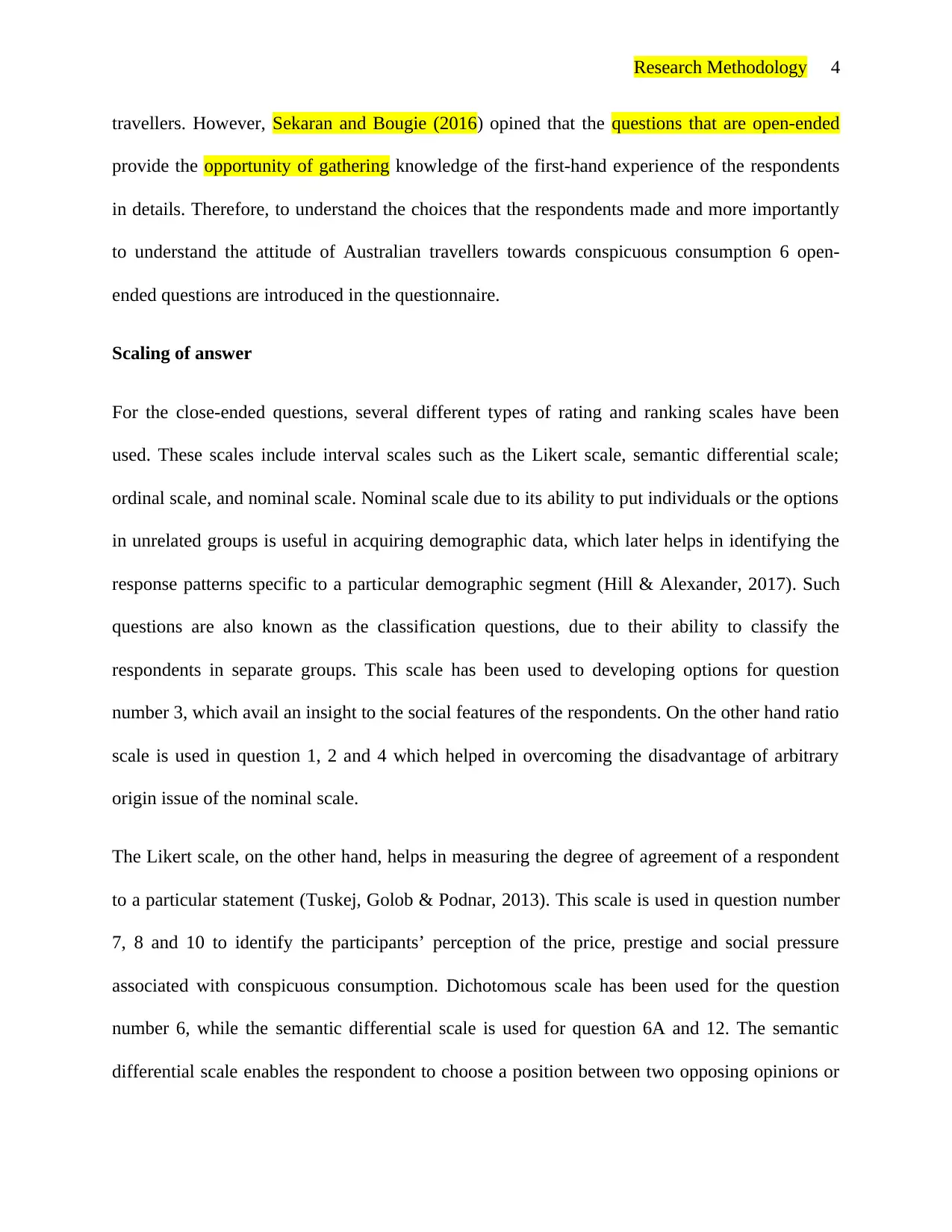
Research Methodology 4
travellers. However, Sekaran and Bougie (2016) opined that the questions that are open-ended
provide the opportunity of gathering knowledge of the first-hand experience of the respondents
in details. Therefore, to understand the choices that the respondents made and more importantly
to understand the attitude of Australian travellers towards conspicuous consumption 6 open-
ended questions are introduced in the questionnaire.
Scaling of answer
For the close-ended questions, several different types of rating and ranking scales have been
used. These scales include interval scales such as the Likert scale, semantic differential scale;
ordinal scale, and nominal scale. Nominal scale due to its ability to put individuals or the options
in unrelated groups is useful in acquiring demographic data, which later helps in identifying the
response patterns specific to a particular demographic segment (Hill & Alexander, 2017). Such
questions are also known as the classification questions, due to their ability to classify the
respondents in separate groups. This scale has been used to developing options for question
number 3, which avail an insight to the social features of the respondents. On the other hand ratio
scale is used in question 1, 2 and 4 which helped in overcoming the disadvantage of arbitrary
origin issue of the nominal scale.
The Likert scale, on the other hand, helps in measuring the degree of agreement of a respondent
to a particular statement (Tuskej, Golob & Podnar, 2013). This scale is used in question number
7, 8 and 10 to identify the participants’ perception of the price, prestige and social pressure
associated with conspicuous consumption. Dichotomous scale has been used for the question
number 6, while the semantic differential scale is used for question 6A and 12. The semantic
differential scale enables the respondent to choose a position between two opposing opinions or
travellers. However, Sekaran and Bougie (2016) opined that the questions that are open-ended
provide the opportunity of gathering knowledge of the first-hand experience of the respondents
in details. Therefore, to understand the choices that the respondents made and more importantly
to understand the attitude of Australian travellers towards conspicuous consumption 6 open-
ended questions are introduced in the questionnaire.
Scaling of answer
For the close-ended questions, several different types of rating and ranking scales have been
used. These scales include interval scales such as the Likert scale, semantic differential scale;
ordinal scale, and nominal scale. Nominal scale due to its ability to put individuals or the options
in unrelated groups is useful in acquiring demographic data, which later helps in identifying the
response patterns specific to a particular demographic segment (Hill & Alexander, 2017). Such
questions are also known as the classification questions, due to their ability to classify the
respondents in separate groups. This scale has been used to developing options for question
number 3, which avail an insight to the social features of the respondents. On the other hand ratio
scale is used in question 1, 2 and 4 which helped in overcoming the disadvantage of arbitrary
origin issue of the nominal scale.
The Likert scale, on the other hand, helps in measuring the degree of agreement of a respondent
to a particular statement (Tuskej, Golob & Podnar, 2013). This scale is used in question number
7, 8 and 10 to identify the participants’ perception of the price, prestige and social pressure
associated with conspicuous consumption. Dichotomous scale has been used for the question
number 6, while the semantic differential scale is used for question 6A and 12. The semantic
differential scale enables the respondent to choose a position between two opposing opinions or
Paraphrase This Document
Need a fresh take? Get an instant paraphrase of this document with our AI Paraphraser
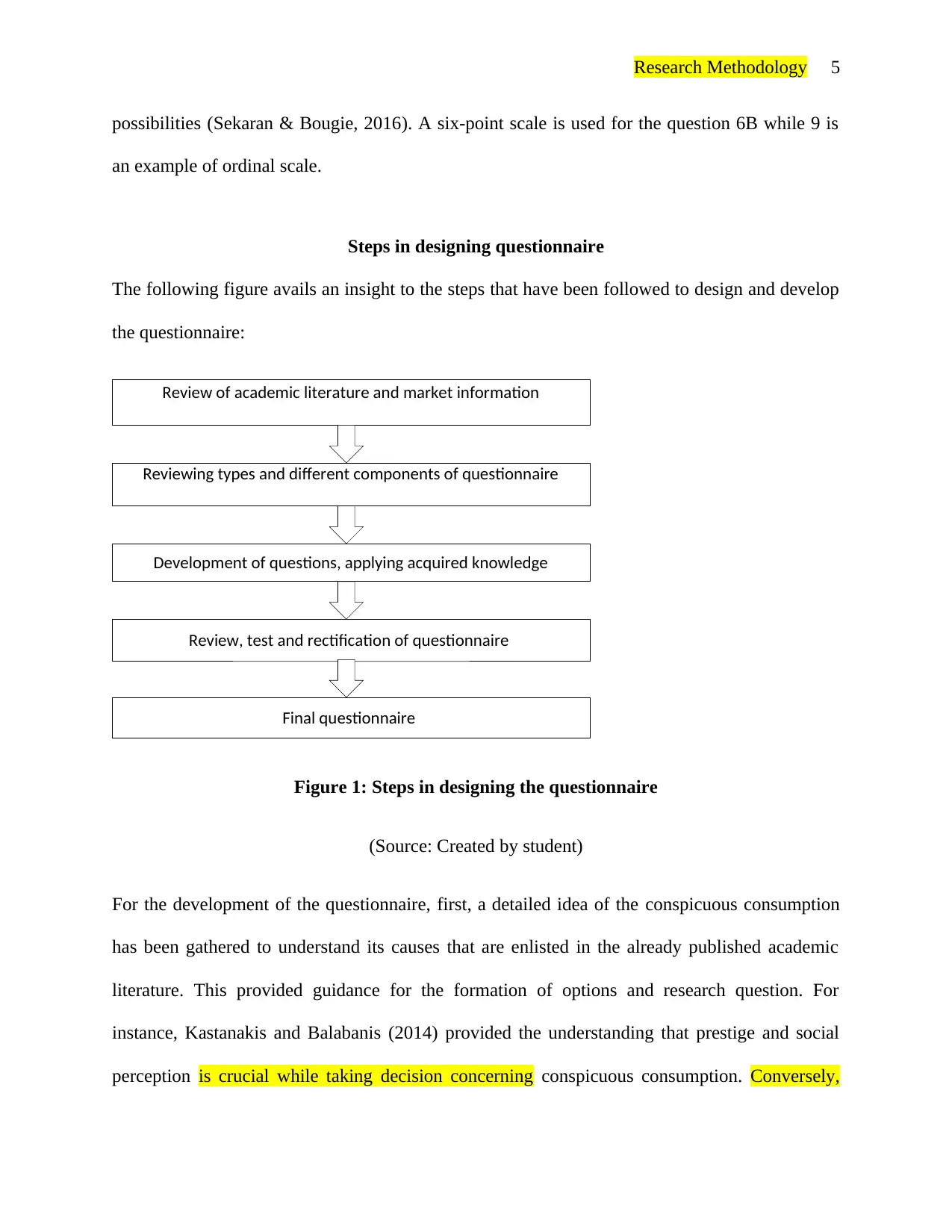
Research Methodology 5
possibilities (Sekaran & Bougie, 2016). A six-point scale is used for the question 6B while 9 is
an example of ordinal scale.
Steps in designing questionnaire
The following figure avails an insight to the steps that have been followed to design and develop
the questionnaire:
Figure 1: Steps in designing the questionnaire
(Source: Created by student)
For the development of the questionnaire, first, a detailed idea of the conspicuous consumption
has been gathered to understand its causes that are enlisted in the already published academic
literature. This provided guidance for the formation of options and research question. For
instance, Kastanakis and Balabanis (2014) provided the understanding that prestige and social
perception is crucial while taking decision concerning conspicuous consumption. Conversely,
Review of academic literature and market information
Reviewing types and different components of questionnaire
Development of questions, applying acquired knowledge
Review, test and rectification of questionnaire
Final questionnaire
possibilities (Sekaran & Bougie, 2016). A six-point scale is used for the question 6B while 9 is
an example of ordinal scale.
Steps in designing questionnaire
The following figure avails an insight to the steps that have been followed to design and develop
the questionnaire:
Figure 1: Steps in designing the questionnaire
(Source: Created by student)
For the development of the questionnaire, first, a detailed idea of the conspicuous consumption
has been gathered to understand its causes that are enlisted in the already published academic
literature. This provided guidance for the formation of options and research question. For
instance, Kastanakis and Balabanis (2014) provided the understanding that prestige and social
perception is crucial while taking decision concerning conspicuous consumption. Conversely,
Review of academic literature and market information
Reviewing types and different components of questionnaire
Development of questions, applying acquired knowledge
Review, test and rectification of questionnaire
Final questionnaire
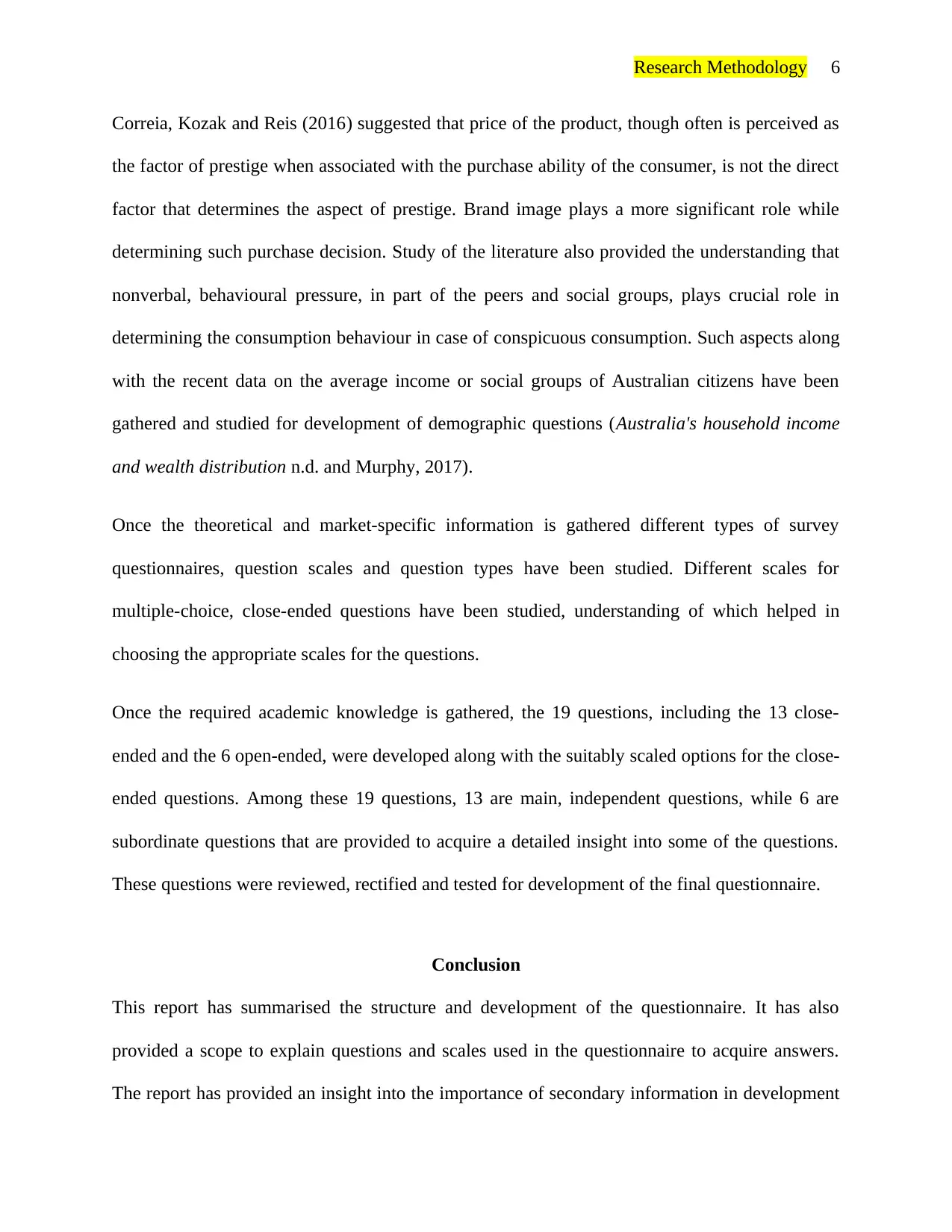
Research Methodology 6
Correia, Kozak and Reis (2016) suggested that price of the product, though often is perceived as
the factor of prestige when associated with the purchase ability of the consumer, is not the direct
factor that determines the aspect of prestige. Brand image plays a more significant role while
determining such purchase decision. Study of the literature also provided the understanding that
nonverbal, behavioural pressure, in part of the peers and social groups, plays crucial role in
determining the consumption behaviour in case of conspicuous consumption. Such aspects along
with the recent data on the average income or social groups of Australian citizens have been
gathered and studied for development of demographic questions (Australia's household income
and wealth distribution n.d. and Murphy, 2017).
Once the theoretical and market-specific information is gathered different types of survey
questionnaires, question scales and question types have been studied. Different scales for
multiple-choice, close-ended questions have been studied, understanding of which helped in
choosing the appropriate scales for the questions.
Once the required academic knowledge is gathered, the 19 questions, including the 13 close-
ended and the 6 open-ended, were developed along with the suitably scaled options for the close-
ended questions. Among these 19 questions, 13 are main, independent questions, while 6 are
subordinate questions that are provided to acquire a detailed insight into some of the questions.
These questions were reviewed, rectified and tested for development of the final questionnaire.
Conclusion
This report has summarised the structure and development of the questionnaire. It has also
provided a scope to explain questions and scales used in the questionnaire to acquire answers.
The report has provided an insight into the importance of secondary information in development
Correia, Kozak and Reis (2016) suggested that price of the product, though often is perceived as
the factor of prestige when associated with the purchase ability of the consumer, is not the direct
factor that determines the aspect of prestige. Brand image plays a more significant role while
determining such purchase decision. Study of the literature also provided the understanding that
nonverbal, behavioural pressure, in part of the peers and social groups, plays crucial role in
determining the consumption behaviour in case of conspicuous consumption. Such aspects along
with the recent data on the average income or social groups of Australian citizens have been
gathered and studied for development of demographic questions (Australia's household income
and wealth distribution n.d. and Murphy, 2017).
Once the theoretical and market-specific information is gathered different types of survey
questionnaires, question scales and question types have been studied. Different scales for
multiple-choice, close-ended questions have been studied, understanding of which helped in
choosing the appropriate scales for the questions.
Once the required academic knowledge is gathered, the 19 questions, including the 13 close-
ended and the 6 open-ended, were developed along with the suitably scaled options for the close-
ended questions. Among these 19 questions, 13 are main, independent questions, while 6 are
subordinate questions that are provided to acquire a detailed insight into some of the questions.
These questions were reviewed, rectified and tested for development of the final questionnaire.
Conclusion
This report has summarised the structure and development of the questionnaire. It has also
provided a scope to explain questions and scales used in the questionnaire to acquire answers.
The report has provided an insight into the importance of secondary information in development
⊘ This is a preview!⊘
Do you want full access?
Subscribe today to unlock all pages.

Trusted by 1+ million students worldwide
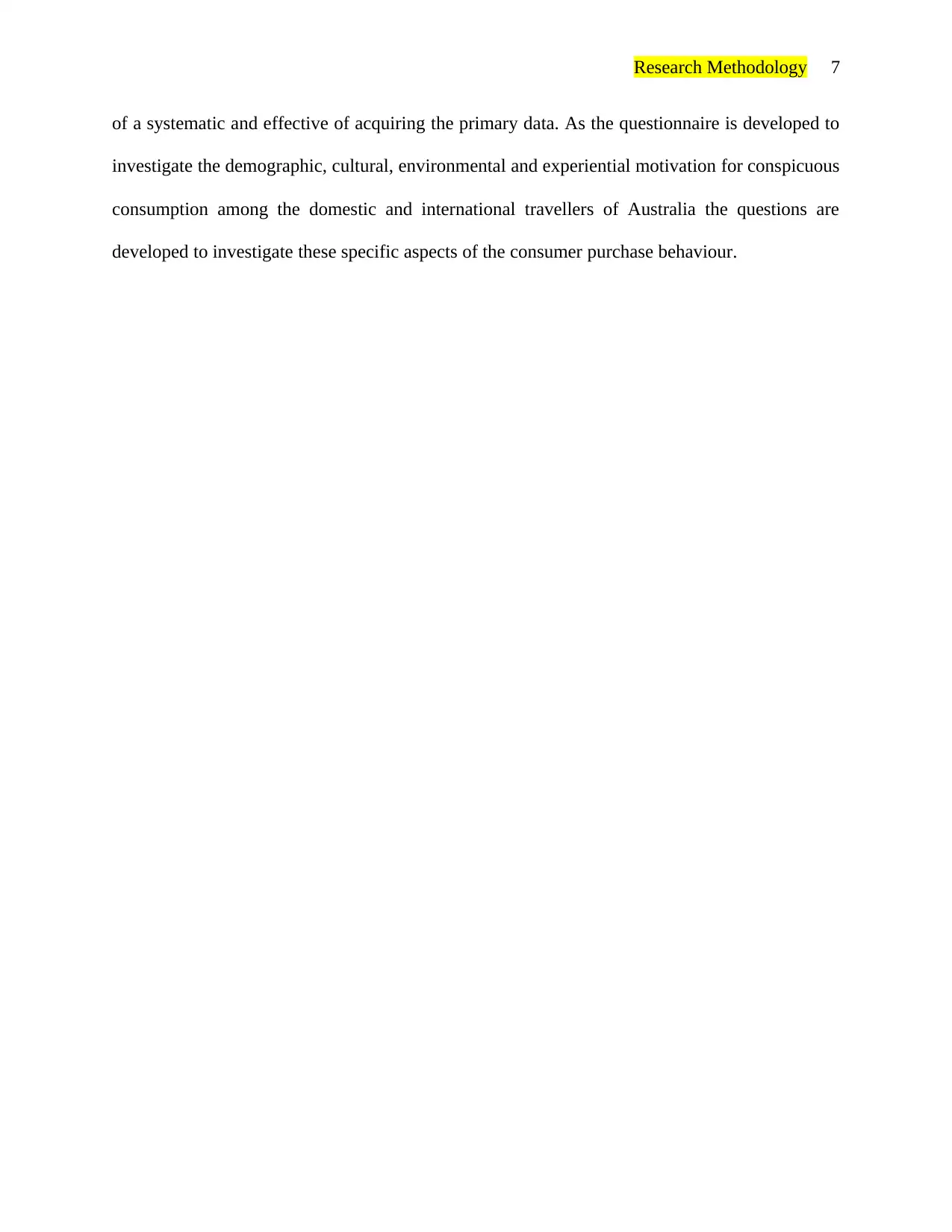
Research Methodology 7
of a systematic and effective of acquiring the primary data. As the questionnaire is developed to
investigate the demographic, cultural, environmental and experiential motivation for conspicuous
consumption among the domestic and international travellers of Australia the questions are
developed to investigate these specific aspects of the consumer purchase behaviour.
of a systematic and effective of acquiring the primary data. As the questionnaire is developed to
investigate the demographic, cultural, environmental and experiential motivation for conspicuous
consumption among the domestic and international travellers of Australia the questions are
developed to investigate these specific aspects of the consumer purchase behaviour.
Paraphrase This Document
Need a fresh take? Get an instant paraphrase of this document with our AI Paraphraser
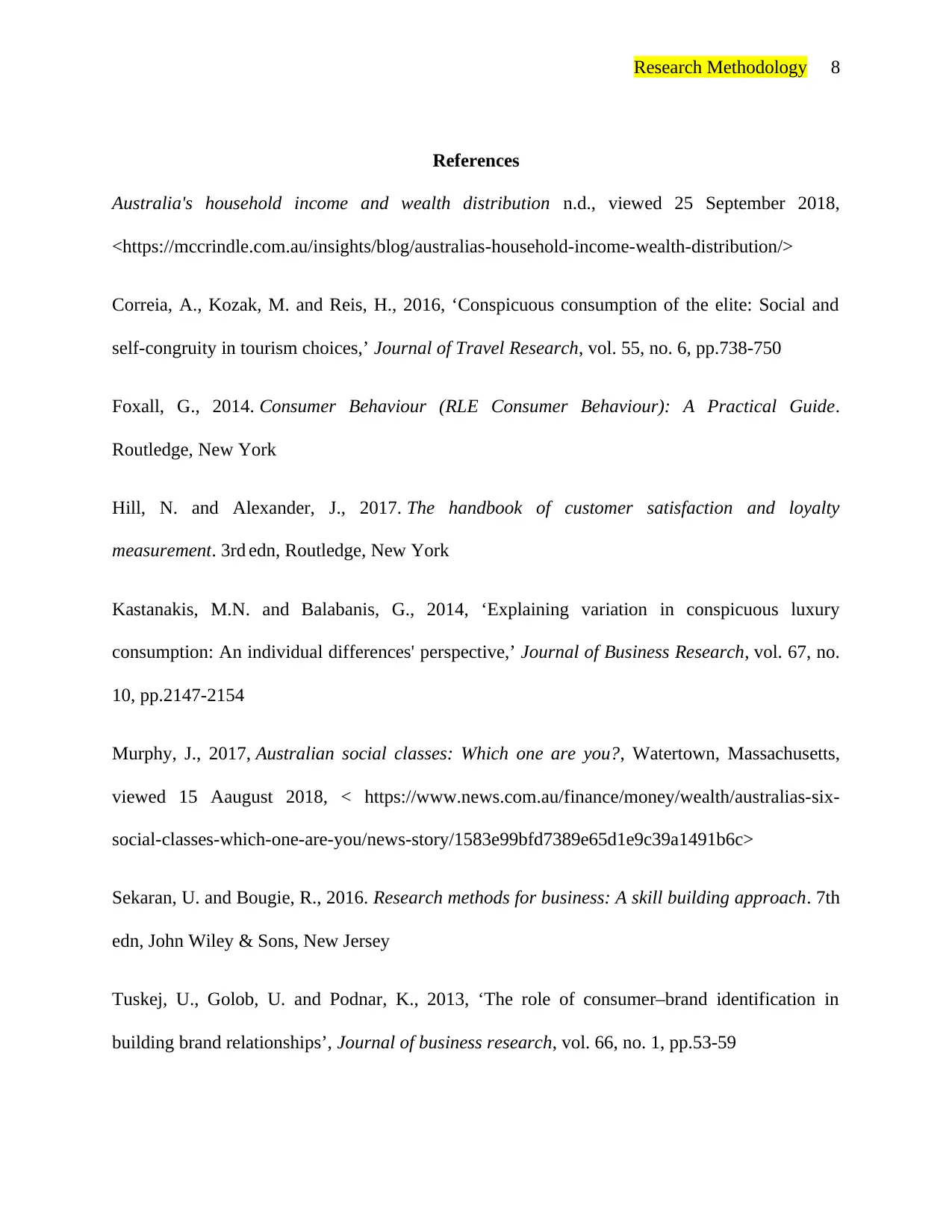
Research Methodology 8
References
Australia's household income and wealth distribution n.d., viewed 25 September 2018,
<https://mccrindle.com.au/insights/blog/australias-household-income-wealth-distribution/>
Correia, A., Kozak, M. and Reis, H., 2016, ‘Conspicuous consumption of the elite: Social and
self-congruity in tourism choices,’ Journal of Travel Research, vol. 55, no. 6, pp.738-750
Foxall, G., 2014. Consumer Behaviour (RLE Consumer Behaviour): A Practical Guide.
Routledge, New York
Hill, N. and Alexander, J., 2017. The handbook of customer satisfaction and loyalty
measurement. 3rd edn, Routledge, New York
Kastanakis, M.N. and Balabanis, G., 2014, ‘Explaining variation in conspicuous luxury
consumption: An individual differences' perspective,’ Journal of Business Research, vol. 67, no.
10, pp.2147-2154
Murphy, J., 2017, Australian social classes: Which one are you?, Watertown, Massachusetts,
viewed 15 Aaugust 2018, < https://www.news.com.au/finance/money/wealth/australias-six-
social-classes-which-one-are-you/news-story/1583e99bfd7389e65d1e9c39a1491b6c>
Sekaran, U. and Bougie, R., 2016. Research methods for business: A skill building approach. 7th
edn, John Wiley & Sons, New Jersey
Tuskej, U., Golob, U. and Podnar, K., 2013, ‘The role of consumer–brand identification in
building brand relationships’, Journal of business research, vol. 66, no. 1, pp.53-59
References
Australia's household income and wealth distribution n.d., viewed 25 September 2018,
<https://mccrindle.com.au/insights/blog/australias-household-income-wealth-distribution/>
Correia, A., Kozak, M. and Reis, H., 2016, ‘Conspicuous consumption of the elite: Social and
self-congruity in tourism choices,’ Journal of Travel Research, vol. 55, no. 6, pp.738-750
Foxall, G., 2014. Consumer Behaviour (RLE Consumer Behaviour): A Practical Guide.
Routledge, New York
Hill, N. and Alexander, J., 2017. The handbook of customer satisfaction and loyalty
measurement. 3rd edn, Routledge, New York
Kastanakis, M.N. and Balabanis, G., 2014, ‘Explaining variation in conspicuous luxury
consumption: An individual differences' perspective,’ Journal of Business Research, vol. 67, no.
10, pp.2147-2154
Murphy, J., 2017, Australian social classes: Which one are you?, Watertown, Massachusetts,
viewed 15 Aaugust 2018, < https://www.news.com.au/finance/money/wealth/australias-six-
social-classes-which-one-are-you/news-story/1583e99bfd7389e65d1e9c39a1491b6c>
Sekaran, U. and Bougie, R., 2016. Research methods for business: A skill building approach. 7th
edn, John Wiley & Sons, New Jersey
Tuskej, U., Golob, U. and Podnar, K., 2013, ‘The role of consumer–brand identification in
building brand relationships’, Journal of business research, vol. 66, no. 1, pp.53-59
1 out of 8
Related Documents
Your All-in-One AI-Powered Toolkit for Academic Success.
+13062052269
info@desklib.com
Available 24*7 on WhatsApp / Email
![[object Object]](/_next/static/media/star-bottom.7253800d.svg)
Unlock your academic potential
Copyright © 2020–2025 A2Z Services. All Rights Reserved. Developed and managed by ZUCOL.



